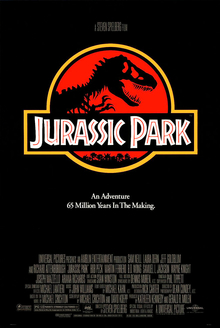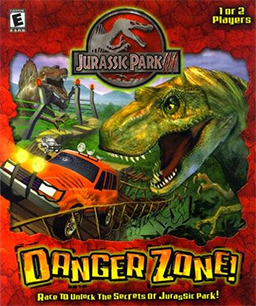
Jurassic Park is a 1993 American science fiction action film directed by Steven Spielberg, produced by Kathleen Kennedy and Gerald R. Molen, and starring Sam Neill, Laura Dern, Jeff Goldblum, and Richard Attenborough. It is the first installment in the Jurassic Park franchise, and the first film in the original Jurassic Park trilogy, and is based on Michael Crichton's 1990 novel of the same name, with a screenplay by Crichton and David Koepp. The film is set on the fictional island of Isla Nublar, off Central America's Pacific Coast near Costa Rica, where a wealthy businessman John Hammond (Attenborough), and a team of genetic scientists have created a wildlife park of de-extinct dinosaurs. When industrial sabotage leads to a catastrophic shutdown of the park's power facilities and security precautions, a small group of visitors, including Hammond's grandchildren, struggle to survive and escape the now perilous island.

An animatronic is a mechatronic puppet. They are a modern variant of the automaton and are often used for the portrayal of characters in films, games and in theme park attractions.

Jurassic Park III is a 2001 American science fiction action film directed by Joe Johnston and written by Peter Buchman, Alexander Payne and Jim Taylor. It is the third installment in the Jurassic Park franchise and the final film in the original Jurassic Park trilogy, following The Lost World: Jurassic Park (1997). It is also the first film in the franchise not to be directed by Steven Spielberg, as well as the first not to be based on a novel by Michael Crichton; however, the film features characters and ideas by Crichton. Sam Neill and Laura Dern reprise their roles from the first film. New cast members include William H. Macy, Téa Leoni, Alessandro Nivola, Trevor Morgan and Michael Jeter. The plot follows a divorced couple who deceive paleontologist Dr. Alan Grant into helping them find their son, who has gone missing on Isla Sorna.

The Lost World: Jurassic Park is a 1997 American science fiction action film. It is the second installment in the Jurassic Park franchise and the second film in the original Jurassic Park trilogy. A sequel to 1993's Jurassic Park and loosely based on Michael Crichton's 1995 novel The Lost World, the film was directed by Steven Spielberg from a screenplay by David Koepp. Jeff Goldblum, Richard Attenborough, Joseph Mazzello and Ariana Richards reprise their roles from the original film with Julianne Moore, Pete Postlethwaite and Arliss Howard joining the cast.

Extreme Dinosaurs is an American animated series produced by DIC Productions, L.P. and Bohbot Entertainment in 1997 based on a 1996 toy line from Mattel. This show is a spin-off of Street Sharks.

The Truth About Killer Dinosaurs is a two-part BBC documentary film, directed by Bill Oddie, in which a group of men test out dinosaur weapons, using studies. The first episode determines the winner of a battle between Tyrannosaurus and Triceratops, and the second compares the strength of an Ankylosaurus and Velociraptor. The episodes were broadcast on BBC 1 in August and September 2005. In the U.S., The Truth About killer Dinosaurs was also known as Dinosaur Face-Off.

Tyrannosaurus rex is unique among dinosaurs in its place in modern culture; paleontologist Robert Bakker has called it "the most popular dinosaur among people of all ages, all cultures, and all nationalities". Paleontologists Mark Norell and Lowell Dingus have likewise called it "the most famous dinosaur of all times." Paleoartist Gregory S. Paul has called it "the theropod. [...] This is the public's favorite dinosaur [...] Even the formations it is found in have fantastic names like Hell Creek and Lance." Other paleontologists agree with that and note that whenever a museum erects a new skeleton or bring in an animatronic model, visitor numbers go up. "Jurassic Park and King Kong would not have been the same without it." In the public mind, T. rex sets the standard of what a dinosaur should be. Science writer Riley Black similarly states, "In all of prehistory, there is no animal that commands our attention quite like Tyrannosaurus rex, the tyrant lizard king. Since the time this dinosaur was officially named in 1905, the enormous carnivore has stood as the ultimate dinosaur."

Jurassic Park: The Ride is a water-based amusement ride based on the Steven Spielberg 1993 film Jurassic Park and Michael Crichton's 1990 novel of the same name which the film is based on located at Universal Islands of Adventure in Orlando, Florida, and Universal Studios Japan in Osaka. It was formerly located at Universal Studios Hollywood in Universal City, California, where it was turned into Jurassic World: The Ride in July 12, 2019.

Warpath: Jurassic Park is a fighting video game released on the PlayStation console in 1999. It is a spin-off of the films Jurassic Park and The Lost World: Jurassic Park, in turn adapted from novels written by Michael Crichton. It was developed by Black Ops Entertainment and co-published by Electronic Arts and DreamWorks Interactive.

Stegosaurus is one of the most recognizable types among cultural depictions of dinosaurs. It has been depicted on film, in cartoons, comics, as children's toys, as sculpture, and even was declared the state dinosaur of Colorado in 1982. Stegosaurus is a subject for inclusion in dinosaur toy and scale model lines, such as the Carnegie Collection.

Jurassic Park III: Danger Zone! is a 2001 video game developed and published by Knowledge Adventure for Microsoft Windows. It is based on the 2001 film Jurassic Park III. Gameplay consists of the player(s) going around on a virtual board game map. Knowledge Adventure also concurrently developed and published Jurassic Park III: Dino Defender. Certain aspects of Dino Defender were re-used for Danger Zone!.

Creature suits are realistic costumes used to disguise a performer as an animal, monster, or other being. They are used in film, television, or as costumed characters in live events. Unlike mascots, they are often made with a high degree of realism. In contrast with prosthetic makeup, which is applied to an actor's skin, the wearer is not normally visible outside their movements controlling the costume, although in some cases, part of the wearer's body is still visible.

Jurassic World: The Ride is a dark water ride attraction that is themed to the Jurassic World series at Universal Studios Hollywood. The original Jurassic Park: The Ride, which operated from June 21, 1996, to September 3, 2018, underwent a major refurbishment and reopened as Jurassic World: The Ride.
Jurassic World Live is a live show produced by Feld Entertainment and NBCUniversal based on the Jurassic World franchise. The show started touring arenas around the United States in September 2019, beginning with the Schottenstein Center in Columbus, Ohio.

Lego Jurassic World is a Lego theme based on the Jurassic World media franchise created by Michael Crichton and centered on a disastrous attempt to create a theme park of cloned dinosaurs. It is licensed from Universal Studios and Amblin Entertainment. The theme was introduced in June 2015, with the release of toy sets and the video game Lego Jurassic World, both to promote the film Jurassic World. Subsequent sets were released in 2018, alongside the next film, Jurassic World: Fallen Kingdom. Various animated projects have also been made, including the 2018 television special Lego Jurassic World: The Secret Exhibit, and the 2019 miniseries Lego Jurassic World: Legend of Isla Nublar.

Jurassic Park, later also referred to as Jurassic World, is an American science fiction adventure media franchise. It focuses on the cloning of dinosaurs through ancient DNA, extracted from mosquitoes that have been fossilized in amber. The franchise explores the ethics of cloning and genetic engineering, and the morals behind de-extinction.

VelociCoaster is a launched roller coaster at Universal Islands of Adventure in Orlando, Florida. Manufactured by Intamin, the ride opened to the public on June 10, 2021. It is themed to the Velociraptor dinosaurs depicted in the Jurassic World film franchise and is located in the Islands of Adventure's Jurassic Park area, occupying the site of the former Triceratops Encounter attraction. VelociCoaster features two high-speed launches powered by linear synchronous motors, a signature 155-foot-tall (47 m) top hat, four inversions, and a maximum speed of 70 mph (110 km/h).

Rexy is the colloquial nickname for a fictional Tyrannosaurus rex that appears throughout the Jurassic Park franchise. She first appeared in Michael Crichton's 1990 novel Jurassic Park, and made her onscreen debut in the 1993 film adaptation, directed by Steven Spielberg. She returns in the 2015 film Jurassic World and its sequels, Jurassic World: Fallen Kingdom (2018) and Jurassic World Dominion (2022).

Velociraptor was popularized by its appearance in the Jurassic Park franchise, which features numerous individuals. They first appear in Michael Crichton's 1990 novel Jurassic Park, followed by a 1993 film adaptation from director Steven Spielberg, which spawned a series of films. Despite their name, Crichton heavily based the Velociraptors on the larger Deinonychus, and this was carried over into the films. The on-screen raptors were created using several production methods, including animatronics by Stan Winston and CGI by Industrial Light & Magic (ILM).


















